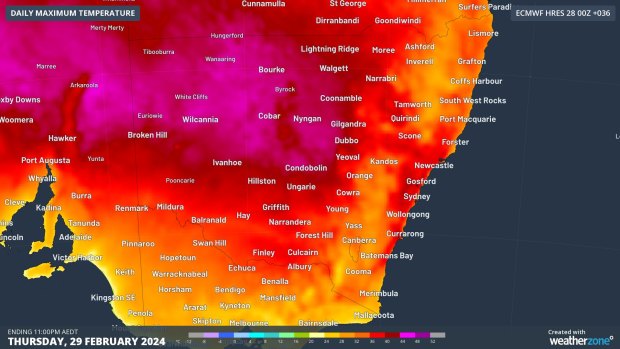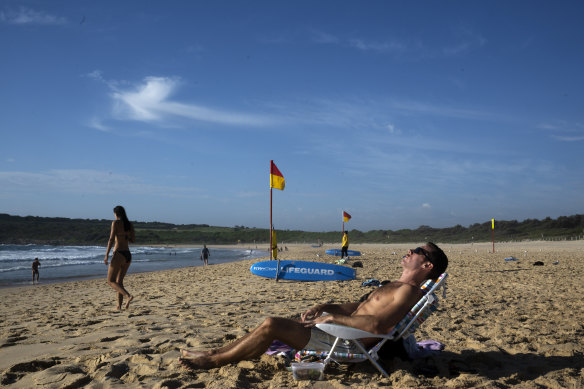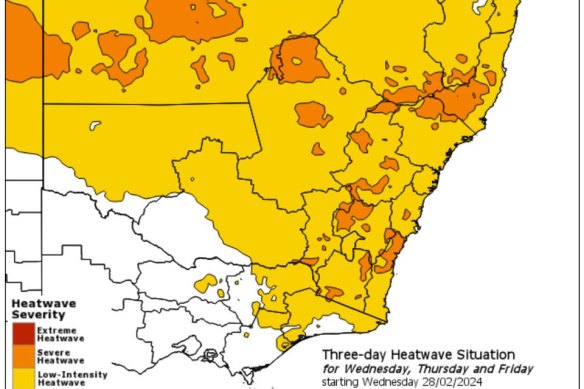Get the air-conditioning cranking and slap on the sunscreen, because summer is saying goodbye with a blistering heatwave.
The Bureau of Meteorology has warned that Thursday will be the peak of the heatwave temperatures for Sydney. The city is expected to hit 35 degrees and the western suburbs 39, making Thursday the hottest February day since 2020.

Parts of Sydney could reach 40 degrees while Canberra will come very close to its hottest day of summer on the very last day of the season, as a large mass of heat pushes to the east coast, Weatherzone predicts. Credit: Weatherzone
The heat in Sydney comes after regional parts of the state suffered through temperatures in the mid-40s on Wednesday, with the hot air headed towards the east coast.
“This was due to a hot north-westerly flow ahead of a trough and cold front moving from South Australia into western NSW and Victoria,” meteorologist Helen Reid said.
“With the widespread heat and the movement of a trough through NSW, there is widespread potential for some thunderstorm activity, although many locations won’t receive any rainfall.
“Along the coast we can expect temperatures to be around 10 degrees above average ahead of the trough with sea breezes having little effect.”

Sydneysiders beat the heat on Thursday. Credit: Louise Kennerley
While a late cool change will bring the temperatures down on Thursday evening, it will take until the weekend for the relief to reach northern parts of the state.
Spare a thought for those in the northern and central parts of NSW who are sweating through severe heatwave conditions with the potential for late-season temperature records.
The Mid North Coast, Hunter, Northern Tablelands, South Coast, Central Tablelands, Southern Tablelands, Snowy Mountains, Central West Slopes & Plains, South West Slopes and Upper Western Districts are all under severe heatwave warnings.
For those wanting to beat the heat on Thursday, other than escaping into air-conditioned offices or jumping in a cold shower, the best place to be in NSW is on the Far South Coast. Narooma is set for a windy day with tops of 31 degrees.

Heatwave warning for NSW.Credit: Bureau of Meteorology
“The South Coast will be spared the worst of the heat with a gusty, cooler southerly change arriving earlier in the afternoon,” Reid said.
As summer in Sydney comes to a close, the Bureau is set to release the nationwide summer summary on Friday, which will provide an insight into the El Nino season.
Weatherzone meteorologist Ben Domensino said it was both a warmer and wetter than average summer.
“We certainly saw some good rain and storm bearing systems coming from the west and moving over parts of eastern NSW,” he said.
“One of the reasons we had quite a lot of moisture fuelling the rainfall this year was significantly above average sea surface temperatures in the Tasman Sea … that helps to cause more evaporation, putting more moisture in the atmosphere.”
Domensino said wind pushing moisture laden air from the Tasman towards NSW contributed to the muggy days, with Sydney recording its muggiest day on record on January 11 when the dew point surpassed 26 degrees.
The dew point measures the temperature at which the air must cool for condensation to occur. Humid days make it harder for sweat on your skin to evaporate in the air, because the atmosphere is already thick with water vapour.
On Thursday morning the dew point reached 23.7. The Bureau considers the dew point to be at oppressive levels once it reaches 24.
“Summer in Sydney always has something people aren’t too pleased with, either too much rain, too high temperatures or bushfires. This year it seemed to be the humidity or the dew point, but compared to the other extreme weather it’s not too bad,” Domensino said.